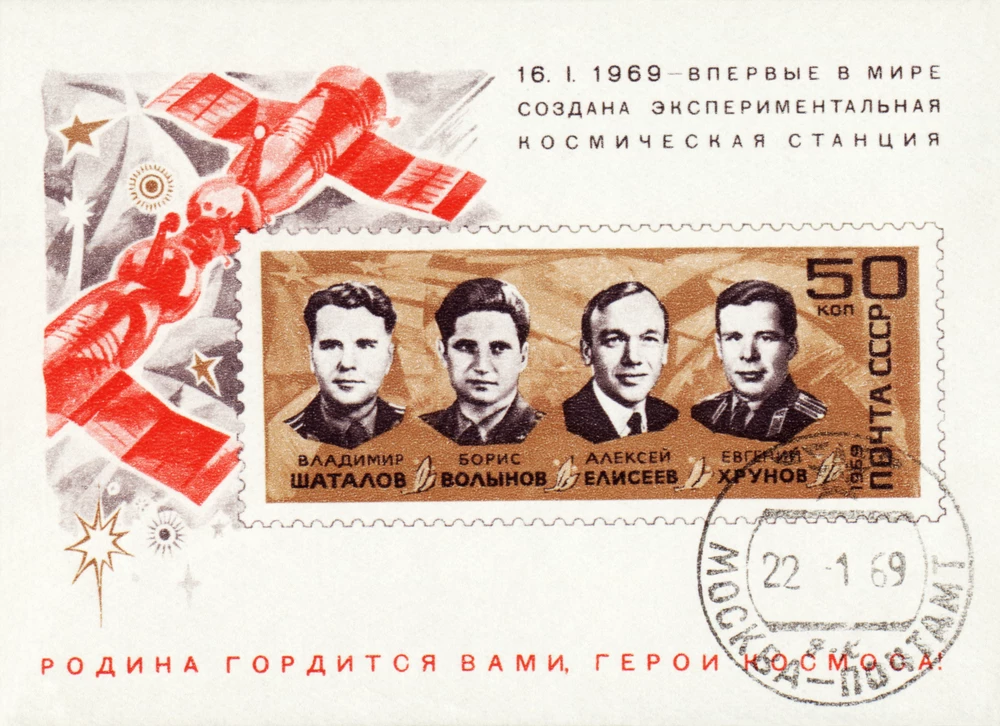January 19, 2009 Forty years ago this week saw one of the most spectacular escapes from certain death in recorded history. Commander Boris Volynov was one of the Soviet Space program’s finest and had missed prime selection five times prior to piloting Soyuz 5 – on several of those occasions he was clearly the Soviet Space Program’s preferred Commander. He had been the reserve Pilot/Cosmonaut on Vostok 3, Vostok 4 and Vostok 5, and the reserve Commander on Voskhod 1 and Soyuz 3. It is believed that Marshal Rudenko continually blocked his selection for flight on the grounds that Volynov’s mother was Jewish, but eventually he got his chance in 1969 aboard Soyuz 5.
In this period, which was at the height of the cold war, there was intense rivalry between the United States and the Soviet Union. The Soviets saw success in this arena as a metaphor for military capability, and unrealistic pressure was brought to bear on the Soviet space program to continually outperform the better-funded NASA.
These political pressures to meet unrealistic deadlines for herculean tasks meant many corners were cut, and there were many tragedies in the Soviet space program, with many still to surface due to the long term disinformation surrounding the area. Indeed, the aforementioned Marshal Mikhail Rudenko disclosed in an interview in 2001 that Yuri Gagarin had not indeed been the first man into space – three had tried and died before him – he was just the first one to return alive.
As the scant details which have become available in the period of glasnost bear testimony, it’s a great wonder that many more cosmonauts didn’t die.

Volynov’s first space flight was in command of Soyuz 5 in January,1969 for the first docking of manned spacecraft and the first transfer of crew.
The RIDE!
Soyuz 4 with Commander Vladimir Shatalov flying solo, met up with Soyuz 5 carrying Volynov, Aleksei Yaliseyev and Eugeni Khrunov on January 16, 1969. After a textbook docking, Yaliseyev and Khrunov spacewalked over to join Shatalov and headed home, leaving Volynov to solo home next day.
It was after retrofire that things went wrong. Explosive bolts were used to detach each stage of the capsule, and this was not to be the first time that the explosive bolts failed to accomplish their required task.
When the bolts didn’t fire, Soyuz 5's service module failed to detach, and this inverted the aircraft as it entered the earth’s atmosphere, leaving the heat shield pointed the wrong way.
When spacecraft return to earth, they don’t need to slow down – the friction of the atmosphere slows them down, creating temperatures as hot as the surface of the sun.
The heat shields on the front of such aircraft are six inches thick, and the 5000 degree temperatures they are subjected to burns away around three inches in a normal re-entry.
The part of Soyuz 5 facing the extreme heat was just one inch thick, and indeed, at command headquarters on planet earth, the hat was already being passed around.
Things got so hot, the module eventually sheared away of its own accord, with the change in weight distribution reorienting the vehicle in the correct direction and saving Volynov from an imminent fiery end.
The heat damage caused by the initially inverted re-entry caused the parachute to only partially deploy, and the soft-landing rockets failed completely, so Soyuz 5 hit the ground very hard. So hard he smashed a number of teeth in the landing.
Volynov extricated himself from the spacecraft to find himself in wilderness in a temperature of minus 38 degrees Celsius (-40 degrees Fahrenheit). Perhaps anticipating that he was hundreds of miles from his planned landing window, and that rescue was hours away, he chose to leave the craft and find shelter.
Extreme Soviet sensitivity to adverse publicity prevented details of what followed from emerging for many decades – the best coverage of what really happened is predictably another James Oberg piece, which can be found here.
After being awarded Hero of the Soviet Union status for his heroics, Volynov probably also gets the gong for the worst case of déjà vu in history – seven years later in his second space flight, he was in command of Soyuz 21 when it failed to separate from docking with the space station Salyut 5.

On 6 July 1976 Volynov and Flight Engineer Vitaly Zholobov were launched on board Soyuz 21 to spend 18 days aboard the space station Salyut 5. Following a deterioration in the health of Zholobov, who was making his first spaceflight, the decision was made to return the crew at the earliest available opportunity and they boarded their Soyuz on 24 August. However, as Volynov tried to undock from Salyut, the latch failed to release properly.
As he fired the jets to move the spacecraft away, the docking mechanism jammed, resulting in the Soyuz being undocked but still linked to Salyut. As the two spacecraft moved out of range of ground communications, only the first set of emergency procedures was received. Volynov tried a second time to undock but only managed to slightly loosen the latches. This situation persisted for an entire orbit (90 minutes), then the final set of emergency procedures were received and the latches finally disengaged.
Volynov is alive and well.
Boris, we salute you!





